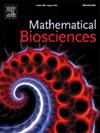非均匀混合降低了疾病患病率
IF 1.8
4区 数学
Q2 BIOLOGY
引用次数: 0
摘要
人类活动和空间异质性决定了感染的空间分布。身体状况、医疗资源的可得性、社会经济地位和出入境筛查等因素可导致不同健康状态人群之间的移动速度和模式(离散扩散时称为栖息地连通性,连续扩散时称为分散核)的变化。虽然运动速率对疾病传播的影响已经被广泛研究,但运动模式的作用仍然知之甚少。在本文中,对于包含欧拉、拉格朗日或混合拉格朗日-欧拉运动的易感-感染-易感(SIS)斑块模型,以及SIS非局部扩散模型,我们导出了与运动无关的全球疾病患病率的上界。在同质环境中,易感个体和受感染个体的非同质混合总是会降低疾病患病率。当易感人群和受感染人群采用相同的分配策略时,患病率达到最高。数值模拟进一步说明了不同运动模式下产生的一些新现象。这些结果加深了我们对人类运动对疾病传播和病原体进化影响的认识,从而改进控制措施,减轻疾病负担。本文章由计算机程序翻译,如有差异,请以英文原文为准。
Nonhomogeneous mixing reduces disease prevalence
Human movement and spatial heterogeneity shape the spatial distribution of infections. Factors such as physical condition, availability of medical resources, socioeconomic status, and exit-entry screening can lead to variations in movement rate and pattern (or called habitat connectivity in discrete diffusion and dispersal kernel in continuous diffusion) among people with different health states. While the effects of movement rate on disease spread have been extensively studied, the role of movement pattern remains less understood. In this paper, for a susceptible–infected–susceptible (SIS) patch model incorporating either Eulerian, Lagrangian, or hybrid Lagrangian–Eulerian movement, as well as an SIS nonlocal dispersal model, we derive an upper bound on the global disease prevalence that is independent of movement. In a homogeneous environment, the nonhomogeneous mixing of susceptible and infected individuals always reduces disease prevalence. The prevalence attains its maximum when the susceptible and infected populations adopt the same distribution strategy. Numerical simulations further illustrate some new phenomena arising from different movement patterns. These results deepen our understanding on the impact of human movement on disease spread and pathogen evolution, thereby improving control measures to reduce disease burden.
求助全文
通过发布文献求助,成功后即可免费获取论文全文。
去求助
来源期刊

Mathematical Biosciences
生物-生物学
CiteScore
7.50
自引率
2.30%
发文量
67
审稿时长
18 days
期刊介绍:
Mathematical Biosciences publishes work providing new concepts or new understanding of biological systems using mathematical models, or methodological articles likely to find application to multiple biological systems. Papers are expected to present a major research finding of broad significance for the biological sciences, or mathematical biology. Mathematical Biosciences welcomes original research articles, letters, reviews and perspectives.
 求助内容:
求助内容: 应助结果提醒方式:
应助结果提醒方式:


